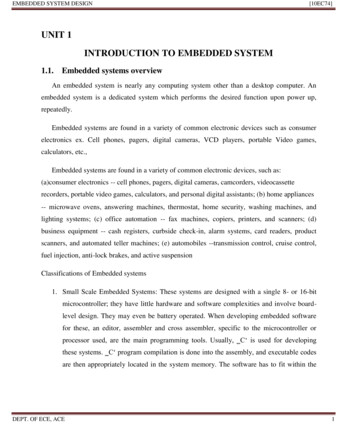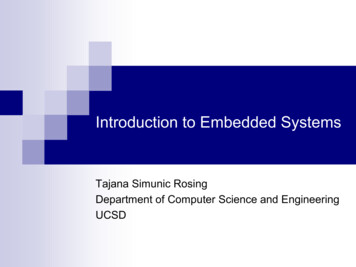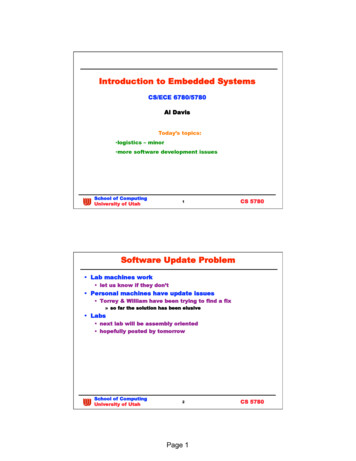
Transcription
EMBEDDED SYSTEM DESIGN[10EC74]UNIT 1INTRODUCTION TO EMBEDDED SYSTEM1.1. Embedded systems overviewAn embedded system is nearly any computing system other than a desktop computer. Anembedded system is a dedicated system which performs the desired function upon power up,repeatedly.Embedded systems are found in a variety of common electronic devices such as consumerelectronics ex. Cell phones, pagers, digital cameras, VCD players, portable Video games,calculators, etc.,Embedded systems are found in a variety of common electronic devices, such as:(a)consumer electronics -- cell phones, pagers, digital cameras, camcorders, videocassetterecorders, portable video games, calculators, and personal digital assistants; (b) home appliances-- microwave ovens, answering machines, thermostat, home security, washing machines, andlighting systems; (c) office automation -- fax machines, copiers, printers, and scanners; (d)business equipment -- cash registers, curbside check-in, alarm systems, card readers, productscanners, and automated teller machines; (e) automobiles --transmission control, cruise control,fuel injection, anti-lock brakes, and active suspensionClassifications of Embedded systems1. Small Scale Embedded Systems: These systems are designed with a single 8- or 16-bitmicrocontroller; they have little hardware and software complexities and involve boardlevel design. They may even be battery operated. When developing embedded softwarefor these, an editor, assembler and cross assembler, specific to the microcontroller orprocessor used, are the main programming tools. Usually, ‗C‘ is used for developingthese systems. ‗C‘ program compilation is done into the assembly, and executable codesare then appropriately located in the system memory. The software has to fit within theDEPT. OF ECE, ACE1
EMBEDDED SYSTEM DESIGN[10EC74]memory available and keep in view the need to limit power dissipation when system isrunning continuously.2. Medium Scale Embedded Systems: These systems are usually designed with a single orfew 16- or 32-bit microcontrollers or DSPs or Reduced Instruction Set Computers(RISCs). These have both hardware and software complexities. For complex softwaredesign, there are the following programming tools: RTOS, Source code engineering tool,Simulator, Debugger and Integrated Development Environment (IDE). Software toolsalso provide the solutions to the hardware complexities. An assembler is of little use as aprogramming tool. These systems may also employ the readily available ASSPs and IPs(explained later) for the various functions—for example, for the bus interfacing,encrypting, deciphering, discrete cosine transformation and inverse transformation,TCP/IP protocol stacking and network connecting functions.3. Sophisticated Embedded Systems: Sophisticated embedded systems have enormoushardware and software complexities and may need scalable processors or configurableprocessors and programmable logic arrays. They are used for cutting edge applicationsthat need hardware and software co-design and integration in the final system; however,they are constrained by the processing speeds available in their hardware units. Certainsoftware functions such as encryption and deciphering algorithms, discrete cosinetransformation and inverse transformation algorithms, TCP/IP protocol stacking andnetwork driver functions are implemented in the hardware to obtain additional speeds bysaving time. Some of the functions of the hardware resources in the system are alsoimplemented by the software. Development tools for these systems may not be readilyavailable at a reasonable cost or may not be available at all. In some cases, a compiler orretarget able compiler might have to be developed for these.The processing units of the embedded system1. Processor in an Embedded System A processor is an important unit in the embeddedsystem hardware. A microcontroller is an integrated chip that has the processor, memoryand several other hardware units in it; these form the microcomputer part of theembedded system. An embedded processor is a processor with special features that allowit to be embedded into a system. A digital signal processor (DSP) is a processor meant forapplications that process digital signals.DEPT. OF ECE, ACE2
EMBEDDED SYSTEM DESIGN[10EC74]2. Commonly used microprocessors, microcontrollers and DSPs in the small-, medium-andlarge scale embedded systems3. A recently introduced technology that additionally incorporates the application-specificsystem processors (ASSPs) in the embedded systems.4. Multiple processors in a system.Embedded systems are a combination of hardware and software as well as other componentsthat we bring together inti products such as cell phones,music player,a network router,or anaircraft guidance system.they are a system within another system as we see in Figure 1.1Figure 1.1: A simple embedded systemBuilding an embedded systemwe embed 3 basic kinds of computing engines into our systems: microprocessor,microcomputer and microcontrollers. The microcomputer and other hardware are connected viaA system bus is a single computer bus that connects the major components of a computersystem. The technique was developed to reduce costs and improve modularity. It combines thefunctions of a data bus to carry information, an address bus to determine where it should be sent,and a control bus to determine its operation.The system bus is further classified int address ,data and control bus.the microprocessorcontrols the whole system by executing a set of instructions call firmware that is stored in ROM.An instruction set, or instruction set architecture (ISA), is the part of the computerarchitecture related to programming, including the native data types, instructions, registers,DEPT. OF ECE, ACE3
EMBEDDED SYSTEM DESIGN[10EC74]addressing modes, memory architecture, interrupt and exception handling, and external I/O. AnISA includes a specification of the set of opcodes (machine language), and the native commandsimplemented by a particular processor. To run the application, when power is first turned ON, themicroprocessor addresses a predefined location and fetches, decodes, and executes the instructionone after the other. The implementation of a microprocessor based embedded system combinesthe individual pieces into an integrated whole as shown in Figure 1.2, which represents thearchitecture for a typical embedded system and identifies the minimal set of necessarycomponents.Figure 1.2 :A Microprocessor based Embedded systemFigure1.3 shows a high level flow through the development process and identifies themajor elements of the development life cycle.DEPT. OF ECE, ACE4
EMBEDDED SYSTEM DESIGNDEPT. OF ECE, ACE[10EC74]5
EMBEDDED SYSTEM DESIGN[10EC74]Figure 1.3 Embedded system life cycleThe traditional design approach has been traverse the two sides of the accompanying diagram separately,that is,Design the hardware componentsDesign the software components.Bring the two together.Spend time testing and debugging the system.The major areas of the design process areEnsuring a sound software and hardware specification.Formulating the architecture for the system to be designed.Partitioning the h/w and s/w.Providing an iterative approach to the design of h/w and s/w.The important steps in developing an embedded system areRequirement definition.System specification.Functional designArchitectural designDEPT. OF ECE, ACE6
EMBEDDED SYSTEM DESIGN[10EC74]Prototyping.The major aspects in the development of embedded applications areDigital hardware and software architectureFormal design , development, and optimization process.Safety and reliability.Digital hardware and software/firmware design.The interface to physical world analog and digital signals.Debug, troubleshooting and test of our design.Figure 1.4: Interfacing to the outside worldEmbedded applications are intended to work with the physical world, sensing variousanalog and digital signals while controlling, manipulating or responding to others. The study ofthe interface to the external world extends the I/O portion of the von-Neumann machine asshown in figure 1.4 with a study of buses, their constitutes and their timing considerations.Exemplary applications of each type of embedded systemDEPT. OF ECE, ACE7
EMBEDDED SYSTEM DESIGN[10EC74]Embedded systems have very diversified applications. A few select application areas ofembedded systems are Telecom, Smart Cards, Missiles and Satellites, Computer Networking,Digital Consumer Electronics, and Automotive. Figure 1.9 shows the applications of embeddedsystems in these areas.DEPT. OF ECE, ACE8
EMBEDDED SYSTEM DESIGN[10EC74]Figure 1.9 Applications of embedded systemsRecommended questions1. What is an embedded system?2. What is the difference between VLSI and embedded systems?3. What are the three kinds of computing engine that are utilized in embedded system?4. How are an embedded microcomputer and supporting hardware elements interconnected?5. An embedded system bus is typically made up of 3 separate buses;what are these?6. What is an instruction cycle?7. An instruction cycle comprises several steps;what are these steps?8. What is an instruction set?DEPT. OF ECE, ACE9
EMBEDDED SYSTEM DESIGN[10EC74]UNIT 2THE HARDWARE SIDEAn introduction, the core level ,Representing information, Understanding numbers addressesinstruction register, Register view of a microprocessor ,Storage elements and Finite stateMachines ,concept of state and time, The state diagram, Finite state machines, A theoreticalmodelTEXT BOOK:1. Embedded Systems-A contemporary Design tool, James K Peckol, John Weily India PvtLtd,2008DEPT. OF ECE, ACE10
EMBEDDED SYSTEM DESIGN[10EC74]UNIT 2THE HARDWARE SIDEIn today‘s hi-tech and changing world, we can put together a working hierarchy of hardware components. At the top, we find VLSI circuits comprising of significant pieces offunctionality: microprocessor, microcontrollers, FPGA‘s, CPLD, and ASIC.Our study of hardware side of embedded systems begins with a high level view of thecomputing core of the system. we will expand and refine that view of hardware both inside andoutside of the core. Figure 2.1 illustrates the sequence.Figure 2.1 Exploring embedded systemsThe core levelFigure 2.2 Four major blocks of an embedded hardware coreDEPT. OF ECE, ACE11
EMBEDDED SYSTEM DESIGN[10EC74]At the top, we begin with a model comprising four major functional blocks i.e., input, output,memory and data path and control depicting the embedded hardware core and high level signalflow as illustrated in figure 2.2.The source of the transfer is the array of eight bit values; the destination is perhaps adisplay. in figure 2.3, we refine the high level functional diagram to illustrate a typical busconfiguration comprising the address, data and control lines.Figure 2.3 A typical Bus structure comprising address, data and control signals.The MicroprocessorA microprocessor (sometimes abbreviated µP) is a programmable digital electroniccomponent that incorporates the functions of a central processing unit (CPU) on a singlesemiconducting integrated circuit (IC). It is a multipurpose, programmable device that acceptsdigital data as input, processes it according to instructions stored in its memory, and providesresults as output. It is an example of sequential digital logic, as it has internal memory.Microprocessors operate on numbers and symbols represented in the binary numeral system.A microprocessor control program can be easily tailored to different needs of a product line,allowing upgrades in performance with minimal redesign of the product. Different featuresDEPT. OF ECE, ACE12
EMBEDDED SYSTEM DESIGN[10EC74]can be implemented in different models of a product line at negligible production cost. Figure 2.4shows a block diagram for a microprocessor based system.Figure 2.4 : A block diagram for a microprocessor based systemThe microcomputerThe microcomputer is a complete computer system that uses a microprocessor as itscomputational core. Typically, a microcomputer will also utilizes numerous other large scaleintegrated circuits to provide necessary peripheral functionality. The complexity ofmicrocomputers varies from simple units that are implemented on a single chip along with asmall amount of on chip memory and elementary I/O system to the complex that will augmentthe microprocessor with a wide array of powerful peripheral support circuitry.The microcontrollerA microcontroller (sometimes abbreviated µC, uC or MCU) is a small computer on asingle integrated circuit containing a processor core, memory, and programmable input/outputperipherals. Program memory in the form of NOR flash or OTPDEPT. OF ECE, ACE13
EMBEDDED SYSTEM DESIGNDEPT. OF ECE, ACE[10EC74]14
EMBEDDED SYSTEM DESIGN[10EC74]ROM is also often included on chip, as well as a typically small amount of RAM.Microcontrollers are designed for embedded applications, in contrast to the microprocessors usedin personal computers or other general purpose applications.Figure 2.5 shows together the microprocessor core and a rich collection of peripherals and I/Ocapability into a single integrated circuit.Microcontrollers are used in automatically controlled products and devices, such asautomobile engine control systems, implantable medical devices, remote controls, officemachines, appliances, power tools, toys and other embedded systems. By reducing the size andcost compared to a design that uses a separate microprocessor, memory, and input/outputdevices, microcontrollers make it economical to digitally control even more devices andprocesses. Mixed signal microcontrollers are common, integrating analog components needed tocontrol non-digital electronic systems.Figure 2.5 :A block diagram for a microcontroller based systemThe digital signal processorA digital signal processor (DSP) is a specialized microprocessor with an architectureoptimized for the operational need
An embedded system is a dedicated system which performs the desired function upon power up, repeatedly. Embedded systems are found in a variety of common electronic devices such as consumer electronics ex. Cell phones, pagers, digital cameras, VCD











